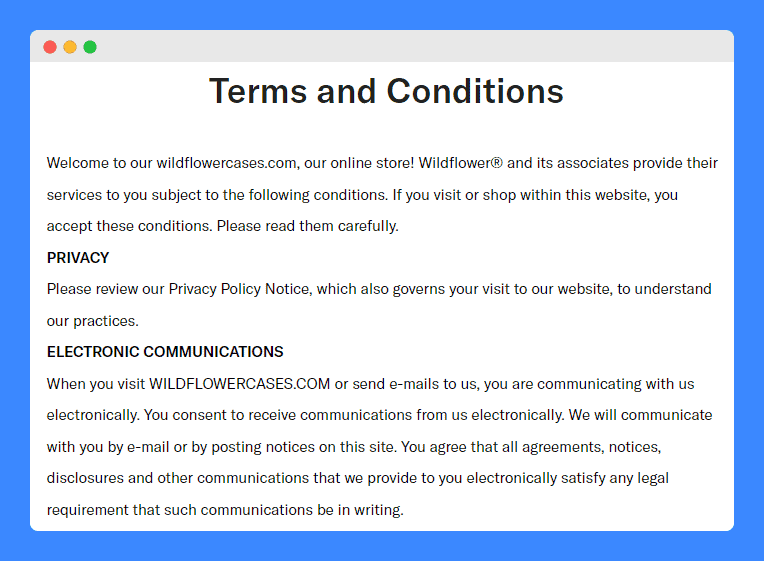Terms and conditions are essential for any business. They set the rules for using a service.
Understanding terms and conditions can protect both parties. These agreements define rights and responsibilities. They help prevent misunderstandings and disputes. In this blog, we’ll explore why terms and conditions matter. We’ll discuss key elements to include in them. By the end, you’ll have a clear idea of how to create effective terms and conditions.
This knowledge can safeguard your business and build trust with your customers. Let’s dive into the world of terms and conditions and discover their importance.
Credit: www.enzuzo.com
Legal Framework
Creating a Terms and Conditions agreement is essential for any website or business. This document sets the rules and guidelines for users. It serves as a legal framework, protecting both the business and its users. Understanding its components ensures compliance and safeguards against potential issues.
Compliance With Laws
Your Terms and Conditions must comply with local and international laws. This includes data protection regulations and consumer rights. Ignoring these laws can lead to legal trouble. It is crucial to stay updated with legal requirements. Regular updates to your terms are necessary.
Protection Against Liability
A well-crafted Terms and Conditions agreement protects against liability. It limits your responsibility for user actions. It also sets boundaries for acceptable behavior. Clearly define what users can and cannot do. This reduces the risk of legal claims. It provides a clear understanding of mutual expectations.

Credit: termly.io
User Rights
User rights within terms and conditions outline what users can and cannot do on a platform. They ensure fair access and protect both parties. Reading these rights helps users understand their privileges and responsibilities.
### User Rights Understanding your rights is essential when it comes to navigating terms and conditions. User rights are designed to protect you, ensuring a fair and transparent relationship between you and the service provider. You have the right to know how your information is collected, used, and shared. You also have the right to access, rectify, and delete your data. But these rights don’t just exist on paper; they’re actionable and impactful. ### Privacy Policies Privacy policies are more than just legal jargon. They outline how your personal information is handled. Why should you care? Because privacy policies tell you exactly what data is collected, how it’s used, and who it’s shared with. Imagine signing up for a new service. You enter your name, email, and maybe even payment information. The privacy policy should explain what happens next. Do they share your email with third parties? Can they sell your data? These are crucial details you need to know. ### Data Protection Data protection goes hand in hand with privacy policies. It’s about safeguarding your information from unauthorized access and breaches. Ever heard of a data breach? It’s when sensitive information gets exposed due to weak security. This can lead to identity theft, financial loss, and other headaches. How can you ensure your data is protected? Look for services that use encryption and other security measures. Check if they comply with data protection laws like GDPR. These laws are designed to give you more control over your data. Have you ever had your data compromised? If so, you know the importance of robust data protection. ### Practical Tips – Read the Terms: Always read the terms and conditions before agreeing. Know your rights. – Check Privacy Policies: Understand how your data is used and shared. – Ensure Data Protection: Look for security measures and legal compliance. Your rights are there to protect you. Make sure you understand them.Intellectual Property
When creating a website or an online service, it’s crucial to protect your creative works and brand identity. This is where the ‘Intellectual Property’ section of your Terms and Conditions comes into play. It ensures that others cannot misuse your content, logos, or brand name. Let’s break this down into two key areas: copyrights and trademarks.
Copyrights
Copyrights are about safeguarding your original content. This includes text, images, videos, and even the design of your site.
Imagine you’ve spent hours writing blog posts or creating unique graphics for your website. You wouldn’t want someone else to copy and use them without your permission, right?
By stating that you hold the copyrights to all content on your site, you make it clear that unauthorized use is prohibited. This can be as simple as adding a line like, “All content on this site is the property of [Your Name/Your Company] and protected by copyright laws.”
Don’t forget to mention the consequences of copyright infringement. You can state that violators will be subject to legal action, which acts as a strong deterrent.
Trademarks
Trademarks protect your brand identity, including your logo, company name, and slogans. These elements distinguish you from competitors.
Consider your brand as your reputation. If someone uses your logo without permission, it can confuse customers and dilute your brand value.
To protect your trademarks, include a statement like, “The trademarks, logos, and service marks displayed on this site are registered and unregistered trademarks of [Your Name/Your Company].” This makes it clear that these elements cannot be used without your explicit consent.
It’s also wise to register your trademarks legally. This provides an extra layer of protection and makes it easier to take legal action if someone infringes on your rights.
Have you ever thought about how much your brand name is worth? Protecting it through trademarks can save you a lot of trouble down the road.
In conclusion, the ‘Intellectual Property’ section in your Terms and Conditions is not just a formality. It’s a vital part of protecting your creative works and brand identity. Make sure to be clear and specific about your copyrights and trademarks to prevent any misuse.
Usage Guidelines
The ‘Usage Guidelines’ section is crucial for ensuring a safe online experience. It sets the boundaries for how users can interact with the platform. Clear guidelines help maintain a respectful and secure environment for everyone. Following these rules benefits all users and protects the integrity of the platform.
Acceptable Use
Users should engage with the platform in a respectful manner. Always use the service for its intended purpose. Ensure that all content shared aligns with community standards. Be kind and considerate in interactions with others. Respect the privacy and rights of other users. Always provide accurate and truthful information.
Prohibited Actions
Certain behaviors are not allowed on the platform. Do not share offensive or harmful content. Avoid spamming or flooding the platform with repetitive messages. Do not engage in illegal activities or promote unlawful behavior. Never attempt to hack or disrupt the platform’s operations. Avoid sharing misleading or false information. Respect copyright and intellectual property rights.
Termination Clause
The Termination Clause in terms and conditions is crucial. It outlines scenarios where agreements can end. Understanding this clause helps protect your interests.
Grounds For Termination
Grounds for termination are specific reasons for ending an agreement. Common grounds include violation of terms, fraud, or misuse of services. Sometimes, inactivity or non-payment also lead to termination.
It’s important to know these grounds. They help you avoid breaches. Always review this part carefully.
Consequences For Violations
Violating terms can have serious consequences. Immediate termination of services is one. You may lose access to accounts or data. Sometimes, penalties or fines are imposed.
Understanding these consequences is key. It ensures compliance and avoids legal issues. Always adhere to the terms to prevent violations.
Dispute Resolution
In the realm of Terms and Conditions, Dispute Resolution is vital. It outlines how conflicts between parties will be handled. Clear dispute resolution terms can prevent future misunderstandings.
Arbitration Procedures
Arbitration is a common method for resolving disputes. It involves a neutral third party. This arbitrator listens to both sides and makes a decision. The decision is usually binding. Arbitration can be faster and less costly than court trials. Both parties must agree to arbitration in the Terms and Conditions. This agreement outlines the process and rules to follow. It also includes how to select an arbitrator.
Jurisdiction
Jurisdiction defines where disputes will be resolved. It specifies the legal authority that will govern the dispute. This can be a specific state or country. It is important to include jurisdiction in your Terms and Conditions. It helps avoid confusion about where to file a lawsuit. Jurisdiction clauses can save time and reduce legal costs.
Updates And Modifications
In today’s fast-paced digital world, updates and modifications to terms and conditions are inevitable. Companies must keep their policies current to reflect changes in laws, technology, and business practices. Regularly updating these terms ensures clarity and protects both the company and its users. Understanding how these updates work is crucial.
Notification Of Changes
Companies need to inform users about any changes to their terms and conditions. This notification can come through email, a website banner, or a pop-up message. Clear communication helps users stay aware of their rights and obligations. Transparency builds trust and encourages users to stay engaged with the service.
Effective Date Of Changes
The effective date of changes indicates when the new terms become active. This date gives users a clear timeline for when they need to comply with the updated terms. It also allows users to review the changes and decide if they agree with them. Companies usually provide a grace period before the changes take effect.
Understanding updates and modifications in terms and conditions is essential for every user. It ensures that you are always aware of your rights and obligations. Stay informed and keep your digital interactions safe and transparent.

Credit: www.websitepolicies.com
Frequently Asked Questions
What Should I Write In My Terms And Conditions?
Include user guidelines, privacy policies, refund and cancellation terms, liability disclaimers, and dispute resolution methods. Specify governing law.
What Is Standard Terms And Conditions?
Standard terms and conditions are predefined rules and guidelines for business transactions. They outline responsibilities, rights, and obligations.
What Is The Meaning Of Term And Condition?
Terms and conditions outline the rules, requirements, and guidelines that users must agree to follow when using a service or product. They define the legal relationship between the provider and the user.
How Do You List Terms And Conditions?
To list terms and conditions, start with an introduction. Outline the rules, user responsibilities, and limitations. Include sections on privacy, payment terms, and dispute resolution. Use clear, concise language and organize content with headings and bullet points.
Conclusion
Understanding terms and conditions is crucial for any user. They protect both parties. Reading them helps avoid future issues. Always review them before agreeing. This ensures you know your rights. It also clarifies your responsibilities. Stay informed and safe online.
Taking a few minutes can save you trouble later. So, next time, take a moment. Read the terms and conditions. It’s worth it.


